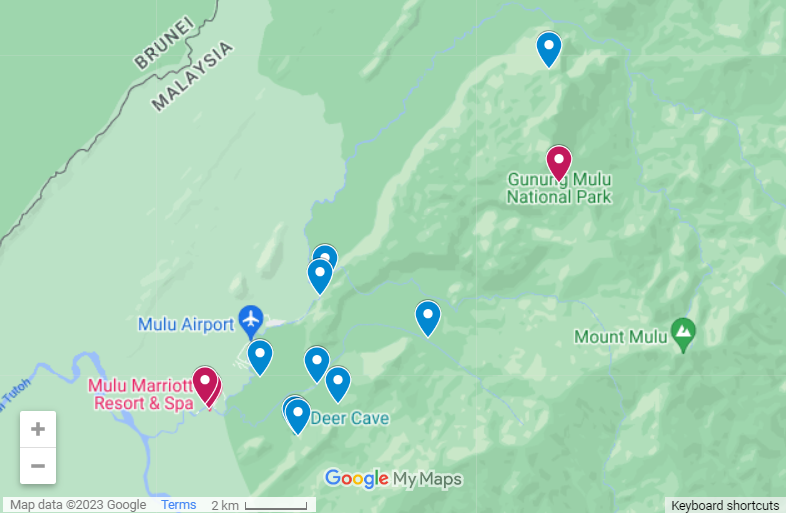Going on a trip to Mulu National Park and want to know all the best things to do in Gunung Mulu National Park? We have you covered! Below you will find our guide to all the best attractions in Gunung Mulu, Sarawak, the accommodation options, the food, everything to plan your ultimate trip.
Gunung Mulu National Park (also referred to as Mulu National Park, Mulu Caves National Park Sarawak or Mulu World Heritage Area) is one of the top places to visit in Sarawak and for good reason. The millions-of-years-old caves, 60 million year old rainforest and unique flora and fauna are fascinating and easy to visit with a plane ticket and a tour package.
Don’t make the mistake of thinking this is a typical national park. This 529 square kilometre national park is not connected by road to the rest of Malaysia. It has two mountains including Mulu Mountain (2376m), primary rainforest, geological formations like nowhere else and absolutely massive caves. It’s UNESCO World Heritage listed for a reason and, actually, it met all four criteria for listing when it only needed to meet one.
It took me far too many years of visiting Malaysia before I made it to Borneo Mulu National Park. That extra flight seemed like a flight too far, but that was crazy. Visiting Gunung Mulu National Park Malaysia should be on everyone’s bucket list!
It’s my new, ABSOLUTE FAVOURITE place in Malaysia! And I love so many places in Malaysia.
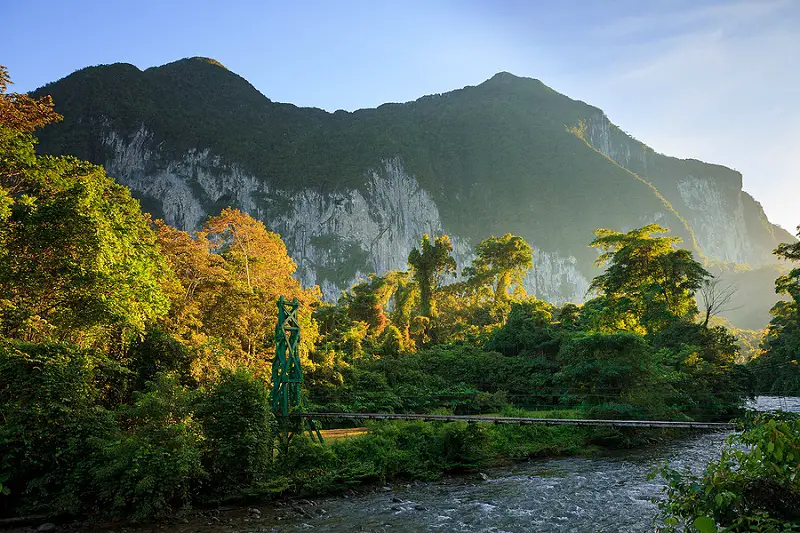
It’s truly a beautiful and amazing slice of the world that has to be experienced to understand and appreciate.
But it can seem a little trickier to visit here than most places. You can’t go to Agoda and book your stay online.
However, it’s also not that hard. This guide is here to demystify the experience, show you exactly what to do in Mulu National Park and how, where to stay, where to book and basically ensure you understand what it’s like to visit here and how to make it happen.
Below, you will find our full Mulu National Park blog with everything you need to know about visiting Gunung Mulu National Park, Malaysia as well as the best places to stay for your ultimate holiday in Mulu Gunung National Park.
There is also a handy map of the places to visit in Sarawak Mulu National Park, instructions on how to get there, information about Gunung Mulu National Park Headquarters, many Gunung Mulu National Park photos, where you can eat and everything else you need to know exactly how to visit Mulu National Park and plan your ultimate Mulu trip. Consider this your full guide book and Gunung Mulu National Park review.
Travelling to Malaysia? Click here to download your free Malaysia Trip Planning checklist. We’ll help you get ready for your trip!
Have any questions? Join our Malaysia Travel Planning Facebook group here now! It’s the perfect place to ask any questions and to be inspired.
Contents
Top 12 Things To Do In Gunung Mulu National Park
Here are the best things to do in Mulu National Park in Sarawak. Read through and select the ones that fit your interests and timeframe.
Mulu Discovery Centre

This one of the Gunung Mulu National Park attractions is the perfect place to start your visit. This is because the Mulu Discovery Centre offers an introduction to the park, its geology and its biodiversity.
This small museum/set of exhibits is between the Park Headquarters and Cafe Mulu in the national park. It’s air-conditioned so a great respite from the humidity outside as well!
There’s some great background information to the area, and I really recommend you come here when you first arrive. I didn’t see anyone else visit here which is a shame. You’ll get more out of your tours after reading the information here.
Show Caves (Deer Cave, Lang Cave, Clearwater Cave and Wind Cave)

You are no doubt in Mulu to explore some caves and this is definitely the #1 thing to do in Mulu National Park. It’s an absolute must do! And I highly recommend you visit all four of these caves during your visit.
The history of the Mulu Caves starts about 5 million years ago when the first caves started to form here. Sideways movements of the Earth lead to the formation of side-by-side limestone and sandstone mountains.
Add in millions of years of heavy rain and this flowing water cut out the huge cave complex that you can visit at Mulu. In fact, this is still continuing today with caves shaping and shifting as time goes by.
The Mulu Caves have also attracted attention from adventure seekers and cave enthusiasts. The challenging terrain and the allure of exploring vast cave systems has drawn explorers and cavers from around the world. Adventurous expeditions have pushed the boundaries of cave exploration, mapping new passages and documenting their geological formations.
Although you don’t have to be adventurous to come here to enjoy and learn about the caves. Today, it’s never been easier to visit with a range of Show Caves and tours to make it extra easy and interesting.
Show caves basically means caves you can visit without having any special equipment or training. There are also adventure caves (described below) which require more skill. The Gunung Mulu National Park activities I am talking about in this thing to do are the Show Caves.
The Show Caves are deep in the rainforest, and it does take some trekking, boating and effort to get to them. However, things are made as straightforward as possible these caves.
There are more Gunung Mulu National Park facts about these caves in our full guide to Mulu Caves here.

You cannot visit any cave independently. You need to be on a tour. Thankfully, this is easy to do.
The first two caves, Deer and Lang Caves, can be visited on the one tour that leaves every afternoon around 2pm.
These caves are next to each other about a 3.8 kilometre walk from park headquarters on wooden planks. The walk there takes about an hour with the guide stopping along the way to point out interesting fauna and flora. The walk is easy and much of the boardwalk seemed to have recently been replaced.
Deer Cave is the biggest show cave at Mulu Caves in Malaysia and also has the largest cave passage in the world. It’s over two kilometres long and 174 metres high.

You are able to walk about 800 metres inside and get to see many sights including Adam and Eve shower heads which are ceiling spouts that water flows through and Garden of Eden which is a point where the ceiling has collapsed, and you can see out into the rainforest. It’s very pretty.
It’s home to millions of bats, and there is plenty of guano (bat poo) in the cave which smells. Thankfully, there is boardwalk and metal path to walk on so you can avoid it. There are stairs in this cave too, but it’s an easy (albeit a little slippery) walk.
Lang Cave is smaller than Deer Cave with cool stalagmites, stalactites, rimstone pools and limestone shawls. It’s a good contrast to Deer Cave because it is prettier and more intricate whereas Deer Cave amazes with just how big it is.

The tour finishes in time to walk you back to the Bat Observatory in time for the Bat Exodus (more on that below).
Another tour you won’t want to miss is to Clearwater and Wind Caves. This leaves around 9am and takes up to four hours.
Part of what I loved about this tour was the journey to get here – it’s a ride in a longboat through the rainforest. It’s gorgeous and peaceful.

The first stop is at a small Penan (local indigenous group) market. At the market, you can buy Penan handicrafts (woven baskets, mats and jewellery). You then get back on the boat.
The next stop is at Wind Cave. This is named after the cool winds that blow through here. You’ll feel them when you reach the narrowest part of the walk through.

There are some impressive chambers here such as the King’s Chamber which is filled with stalagmites and columns. There are lots of intricate details and formations to check out. It’s quite amazing actually and was my favourite cave. It’s like a much bigger Lang’s Cave.
The walk here is up an incline and there are steps in the cave. Mostly you walk on boardwalk, and it’s not that full on.
You then hop back in the boat and head to nearby Clearwater Cave. This is up 200+ stairs so it does take a little (sweaty) effort to get to this cave.

Clearwater Cave is named after the crystal clear river that runs over 200 kilometres through this cave system. It’s one of the biggest cave systems in the world at 220 kilometres.
You only get to see a small part on this tour (although it is possible to see more for experienced cavers). The cavern you get to walk through is BIG! Although not like the huge Deer Cave. And the roar of the river is clearly heard as it rushes through making this cave even bigger.
That’s part of what makes this cave interesting – that you can see how the river is shaping it. It also has many unique rock formations, stalagmites and more. In some ways, it’s like a combination of the previous caves.

The walk through this cave has quite a lot of stairs including fairly steep ones with a rope. What is great in this cave is that it is a circular route so no back tracking.
After this cave, you do get a chance to swim in the outside lagoon to cool down. The water comes from the cave, and it’s nice and cool. This was one of my highlights of my Mulu visit. It’s such a beautiful spot surrounded by rainforest and the cold water was exactly what my hot and sweaty body needed. Don’t miss it!

There’s a rest area next to this lagoon, and it’s a great place to soak everything in.
It’s then back to Park HQ on the boat. Beautiful!
My description of the caves tours is from my experience booking the tours through Park Headquarters. It’s also possible to book with other operators that may include some extras, although the main parts of the tours will be the same.
I was a little jealous when I was at Clearwater Cave of people who had done alternate tours that included lunch by the swimming lagoon. This would have been so awesome! The choice is yours, of course.
If you are short on time, you could do both of these cave tours in one day and visit all the main show caves. However you need to do it, you are absolutely ripping yourself off if you don’t do both of these tours during your stay at Gunung Mulu National Park.
If you are crazy enough to be here for just half a day, pick the Clearwater and Wind Caves. But please, visit all the caves. You’ll probably only ever be here once 🙂
Click here to read more detailed information in our guide to Mulu Caves.
Bat Exodus

Another popular thing to do at Mulu is to watch the Bat Exodus in the evening. It is quite a sight!
The massive Deer Cave is home to 2.5 to 3.5 million bats of 12 different species who live hanging off the roof. Most evenings, they exit the cave in a big, swirling formation of bats heading up into the sky and out over the rainforest.
Before I visited Mulu, I read they may not exit if it’s raining. However, our guide said that it’s somewhat random and they can exit in heavy rain, and they may not exit on a clear day. I was there on a beautiful, clear day (as you can see in the photo above), and they did not exit.
This usually happens between 5:30 to 6:30pm but it can happen as early as 4pm.
It’s quite a sight. I have never seen anything quite like it.
There is a special Bat Observatory area to watch this from. You can do this as part of the tour to Deer and Lang Caves, but you can also walk here yourself and watch this without doing a tour. It’s about three kilometres/45 minutes from Park Headquarters. Take a torch for the walk back.
Adventure Caving
For those that are more adventurous and have caving experience, you definitely won’t want to miss the opportunity to try some adventurous caving tours while you are at Mulu.
Termed “Adventure Caves”, these are the activities that require training and special equipment. Some of these take place in the Show Caves, but in areas not accessible in the Show Cave tour.
These experiences are classed as beginner, intermediate and advanced and there are rules on what you can do based on previous experience. If you have no caving experience, you can do some of these tours. Just let them know and they’ll work out a program for you.
All these activities have to be booked in a tour and can book out months in advance. The best way to do this is via the Mulu Caves tour company themselves here.
Mulu Canopy Skywalk

Another popular activity is the Mulu canopy walk. This is another activity you can only do in a tour.
Tours depart throughout the morning and are limited to eight people only. This is another activity that books out.
The canopy walk itself is 420 metres long, 25 metres above the ground. It’s anchored on trees and is reputed to be the longest tree-based canopy walks in the world. It is really awesome. The smaller sizes helps you feel more like you are part of the forest.
This is a great way to see the different levels of the rainforest as well as river views and chances to spot birds. I very much enjoyed it. I think it’s the most scenic one I have ever done especially as you walk above a river twice. It felt like I was part of the rainforest while feeling quite safe.
There are information boards along the walk to help you learn more about what you are seeing. There is a guide the whole time too, but since you are in a group and only two people can be in a section at a time, it can be hard to ask your guide questions during the walk. However, they can help you at the end if you don’t get a chance during.
A walk is involved to get to the canopy walk and get back again. All up, this tour requires six kilometres of walking. It’s on boardwalk – the same one that takes you to Deer Cave) and is not difficult. I walked back in about 20 minutes at the end of the canopy walk. I did walk fairly fast though (I had a flight to catch!).
I did this tour at 7am, and I’m glad I did it early. The air was nice and (relatively) cool and it’s a great time of day. If anything, I wish I had done it earlier.
Tree Top Tower

The Tree Top Tower is just a ten minute walk from the Park Headquarters and is a great place to birdwatch.
This is a 30 metre high bird tower which is particularly popular at the best times to spot birds (5am-9am and 4pm-8pm). You can prebook a slot to make sure you don’t miss out.
This is a free attraction in Mulu National Park, but the tower is kept locked and you need to pay a RM50 deposit to borrow the key.
Botanical Heritage Trail

The Botanical Heritage Trail (or Botanic Trail) is a nice trail you can walk without a guide. It has information boards along the walk on plant evolution. There’s also plenty of resting spots including a particularly pretty one by a waterway.
It’s a circular trail which runs for about 1.5 kilometres. It branches off the main trail to Deer Cave about 450 metres from the Park Headquarters. Its circular nature means that it actually passes through this trail twice, so you could easily just walk half of it if you are short of time.
It’s a very easy, flat trail. It’s mostly on boardwalk but the last part is on the ground – something that feels like a rare occurrence at Mulu! It has little bridges over creeks, and it’s all very lovely. I couldn’t help but think it would be perfect for my kids. Nice and easy going. However, I definitely recommend this trail to everyone.
I especially enjoyed this as many of my other walks were with tour groups. I liked having the rainforest to myself. Plus, it was a good opportunity to just focus on the rainforest rather than caves, or canopy walk or something else.
You can easily walk this in half an hour from Park Headquarters return. However, an hour will give you an opportunity to read some of the information boards and enjoy the views.
Night Walk

Another popular activity is a night walk. Guided night walks leave every evening around 7pm and 7:30pm and take 1.5 – 2 hours.
You are likely to see a range of insects, tree frogs, huge spiders, vine snakes and many things you have never heard of.
Take a torch for better views and to see all the creepy eyes in the forest 🙂
Guides really make the night walk, but it is also possible to go on your own night walk. You can’t take the path the guided tours take until after 8pm. If you go walking at night, make sure you let someone know.
Paku Waterfall
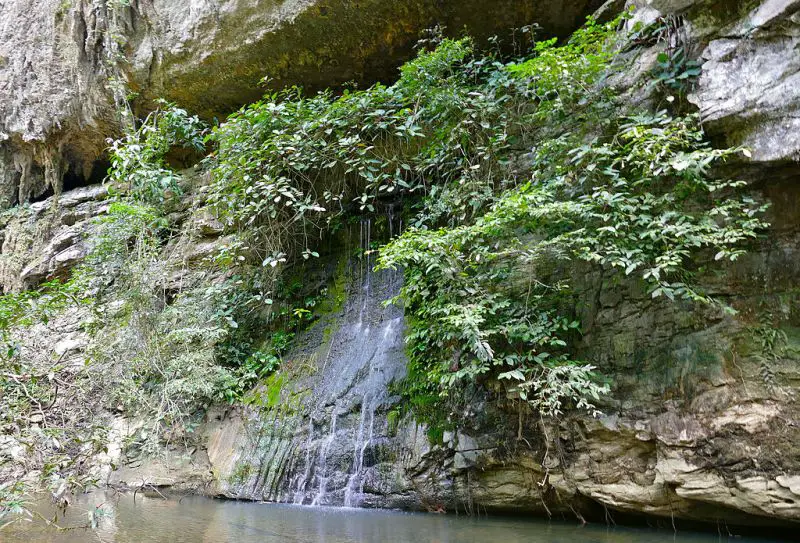
For a more serious walk that you can do without a guide, consider the Paku Valley loop. This 8 kilometre journey takes you to Paku Waterfall where you can swim.
The walk starts by following the walk to Deer Cave. About 1.3 kilometres after leaving Park Headquarters, you walk down to the forest floor to follow a trail along the Paku River.
It’s an easy trail but it is often muddy and you need to cross streams.
You must register before leaving.
The Pinnacles
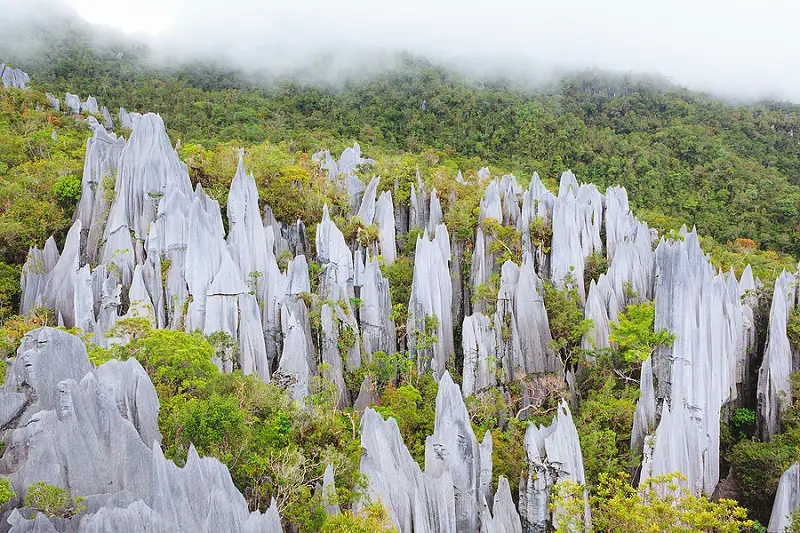
The caves aren’t the only things famous at Gunung Mulu National Park – so are the Pinnacles. Mulu National Park is home to this amazing geological formation which is a collection of 50 metre high jagged limestone spires. They are on the slopes of Mount Api.
This is a 3 day/2 night trekking adventure which is rated as an extreme activity by the park due to the climbing involved. This is not a beginner hike. People have died on this trek and while that is very rare, this is not something to sign up to if you don’t have a great level of fitness or climbing ability. It’s also not a trek for people who are afraid of heights.
I did not do this Pinnacle Mulu National Park trek, so I cannot share my experiences. However, I can share what it involves so you can consider it. Numbers are limited on this trek and it is popular, so book in advance if it interests you.
The first day is a boat ride on the Melinau River where you can optionally do the Clearwater Cave tour. You then continue on to Kuala Litut which is the start of the 9 kilometre hike to Camp 5 which is where you’ll stay. This trek is an easy, flat walk.
Camp 5 is a forest shelter with basic accommodation. It’s a raised platform with half walls and no doors and windows. There are mats to sleep on, but you need your own bedding. You can pay a deposit to borrow bedding from Park Headquarters before you leave.
There are cold showers and toilets as well as a kitchen where you can self cater. You need to bring your food with you.
The next day, the hard work begins. The hike starts around 6:30am. It’s only 2.4 kilometres to the top BUT your altitude rises 1200 metres over this time. The last section of the hike (called the Danger Zone) is nearly vertical with 17 rope sections and ladders. It takes 3-5 hours to climb this.
The trek/climb itself offers some good views as it climbs up from Melinau Gorge through limestone forest and past pitcher plants and rare orchids.
There are three checkpoints on the way up, and you have to hit each one by the allocated time or turn back around. This is to ensure you’ll get back to camp in daylight.
At the top, there are spectacular views over the Mulu National Park Pinnacles. Only one hour can be spent up here, so there’s time to descend.
The hiking Mulu Pinnacles already was tough, but many people find the descent more difficult, and it can take over five hours.
At the end of this grueling day, there’s another night at Camp 5. The next day, it’s a 9 kilometre walk back the way you came to Kuala Litut and a boat ride back to Park Headquarters.
You can book this through Park Headquarters (more information here) or a local travel agency. The agency will cost more but may include extras like your food. It’s not possible to do this trek without an organised tour (and you shouldn’t want to. It’s extreme).
Gunung Mulu Summit Trek

An even more extreme challenge is the trek/climb to Gunung (Mount) Mulu Summit. At 2,377 metres high, this adventure takes 4 days/3 nights and starts from only 40 metres altitude. It’s 24 kilometres long.
Again, this option of things to do in Mulu National Park is only for the prepared and experienced. Mulu park personal say that “experienced trekkers/mountaineers describe this trek as more challenging than Mt Kinabalu, even more strenuous than Mt Kilimanjaro”.
You need to take in all your own gear including food, sleeping mat, sleeping bag (nights are cool at Camp 4), gas cartridges for the stoves along the way, first aid kit, head lamp, warm clothing and great hiking boots.
The general itinerary is 8-10 hour day of climbing/hiking to Camp 3 on day 1. Day two is an easier four hour trek onto Camp 4. They generally don’t recommend ascending the summit on this day because the summit is usually covered in clouds in the afternoon.
On day 3, the day usually starts about 3am to get to the top in time for sunrise. Then it usually takes about 5-6 hours back to the camp 4 for lunch before trekking onward to camp 3 for the night.
On the final day, it’s a 6 hour trek back to Park Headquarters.
The views from the summit are meant to be beautiful. You can hire a porter to carry up to 15kg for you.
This may change based on weather conditions, group size and more.
Headhunters’ Trail
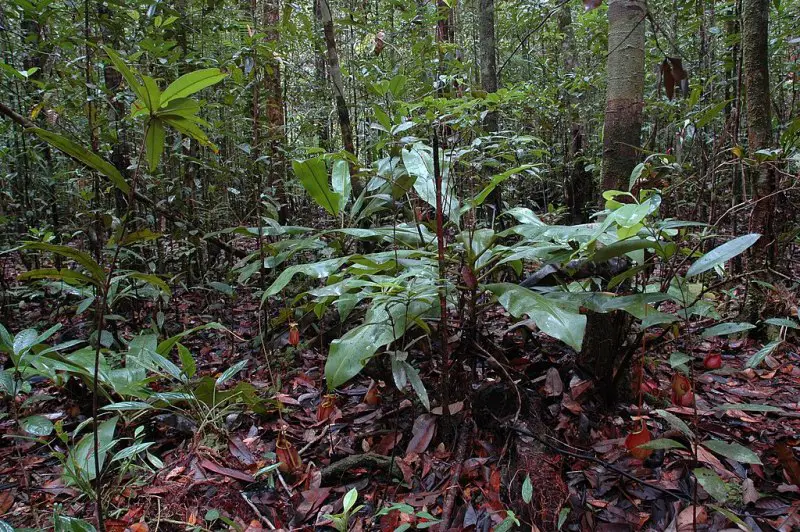
If you want to do some less serious Gunung Mulu hiking than the two options above, you can hike the Headhunters Trail. This is also the way into or out of Mulu National Park if you don’t want to fly. It’s rated moderate difficulty.
The name of this trail comes from the Kayan war parties that used to travel through here on their way to raid the Limbang region.
The Headhunters trail runs from Camp 5 for 11 kilometres in the direction of Limbang. The park itself does not offer this as an activity but some private tour operators do. From the end of this trek, you can take a boat and a van ride onto Limbang by the Brunei border.
You first need to get to Camp 5 which is described above in the Mulu Caves Pinnacles trek. This journey requires a boat ride on the Melinau River then a 9 kilometre hike to Camp 5 which is where you’ll stay. This trek is an easy, flat walk.
Camp 5 is a forest shelter with basic accommodation. It’s a raised platform with half walls and no doors and windows. There are mats to sleep on, but you need your own bedding. While you can borrow bedding from Park Headquarters, this only works if you are going to return there, so you’ll need your own bedding for this trip.
There are cold showers and toilets as well as a kitchen where you can self cater. You need to bring your food with you unless it’s included in your tour.
After a night here, the Headhunter Trail starts the next morning through the forest to Kuala Terikan. This takes 4 – 5 hours. From here, it’s a 1.5 hour boat ride from Medamit. Medamit is linked to Limbang by road.
You can also combine this trail with the Pinnacles Trek. After descending from the Pinnacles, you can take this trail the next day instead of returning to Park Headquarters.
Mulu National Park Headquarters

The Mulu National Park Headquarters (HQ) is the place to head as soon as you first enter the park. This is where you can buy your entry pass (more information below) and arrange any tours. It’s also where you can find the national park accommodation and Mulu Cafe which is the most convenient place to eat.
You’ll find it quite easily.

Once you are arrive at the National Park, you simply walk across a cool swinging bridge over a small river and you’ll find a building in front of you. This is park security. Walk to the right and Park Headquarters will be right in front of you.
Start by registering at the outdoor stall where you can buy your National Park pass. Then you can go inside to get your keys for accommodation or book any tours.

The Mulu National Park HQ is also where you can find maps, more information and where many treks and tours leave from. The staff can also help you plan your Mulu National Park itinerary. However, I do want to stress that tours and accommodation can book out months in advance, so it is better to pre-book, especially if you plan to visit at the peak June to September period.
Connected to here is also the Mulu Discovery Centre and a gift shop where you can buy snacks.
Mulu National Park Entry Fee
You need to purchase a Mulu World Heritage five day pass to enter the national park, do any of the tours or access any of the walks. This lasts for five calendar days. If you are staying longer, you’ll need to buy another pass.
It’s easy to buy this at Park Headquarters on arrival. At the time of publishing, it costs foreigners RM30 for an adult and RM15 for kids 6-18 years old (under 6s are free). For Malaysians, it is RM10 for adults and RM5 for kids.
You’ll be given a coloured wristband with the date that your entry expires and you must wear this when in the park. It gives you access 24 hours a day until the expiry.
Best Place To Stay In National Park Mulu
When it comes to where to stay in Gunung Mulu National Park, there aren’t a lot of choices. There are two main places and then a couple of small guesthouses.
We includes a full review of the two best Mulu National Park accommodation options.
You can also read about all your options here.
BEST – Mulu Marriott Resort And Spa Review
About 2.5 kilometres from the national park entrance, the Mulu Marriott Resort and Spa is by far the best place to stay. This 5 star resort is a luxurious place to return to after a day of exploring caves and rainforest.
Surrounded by the rainforest and a river, you’ll feel like you haven’t left the best of the national park behind. There is a great pool on-site, a gym, day spa, complimentary shuttle to get you around the area (including the airport) and a tour desk to arrange all your activities and tours during your stay.
There is a range of room types including double and king rooms and suites. Double rooms have two double beds. All rooms include air-conditioning, tea and coffee making facilities, minifridge, desk area, television and balcony. They are comfortable, clean and the quality you would expect from a 5 star Marriott hotel.
Suites also have a separate living area.
There is the Marriott Cafe on-site which serves meals all day long including a buffet breakfast. There is also an on-site bar but note that it is pricey.
There is wifi available, but it is slow (which beats other accommodation options in Mulu).
Click here for the latest prices.
Mulu Park HQ Review

The most convenient place to stay in Mulu National Park is definitely the accommodation offered at the Park Headquarters. This way, you are staying right in the park.
There are a few different choices of accommodation from a gorgeous garden bungalow Mulu National Park to hostel dorms. They, of course, have their own price tags. This accommodation can be booked out quite far in advance. Note that there is no camping allowed.
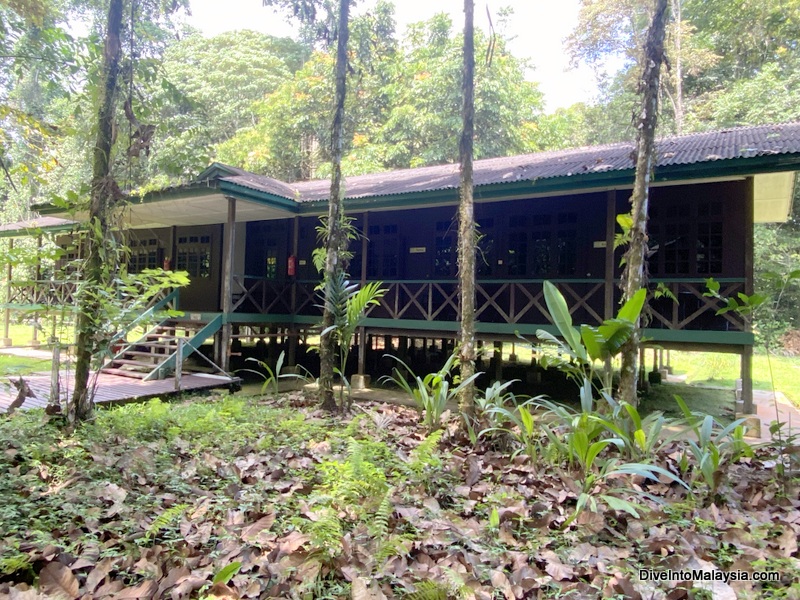
The accommodation is in beautiful gardens surrounded by the rainforest. There is the Cafe Mulu at the Headquarters for eating and all the facilities of the national park. There is also 24 hour electricity but no wifi.
The best accommodation option is the garden bungalows. I stayed in one of these and it was just awesome. There are eight of these with their own terraces. They come with private bathrooms with hot water, air-conditioning, fan, a king sized bed and a super single bed. They can sleep up to three adults.

Next up are the longhouse rooms. These are great for families or groups of friends. There are ten longhouse rooms. Eight of these rooms have 4 single beds each and two are family suites with a king sized bed and 4 single beds each. They have private bathrooms with air-conditioning and fans.
There are also 12 twin rooms in the Rainforest Lodge. They also have air-conditioning, private bathrooms and ceiling fans.
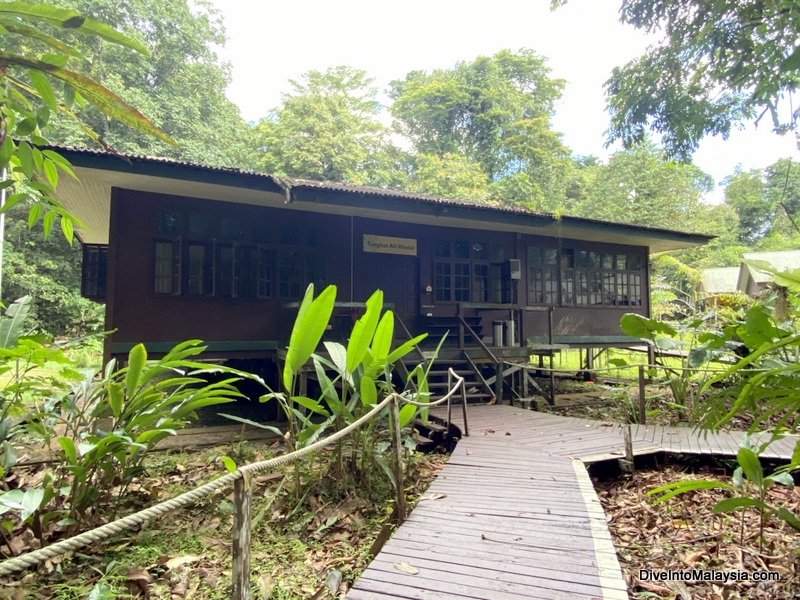
Finally, budget travellers will love the dorm beds. There are 14 dorm beds with a ceiling fan only and a shared bathroom.
All room choices include breakfast and linen. Check-out is at 10am, but there is free luggage storage after this time.
Click here for the latest prices.
Click here to see all our recommendations for the best accommodation in Mulu National Park.
Eating Options At Gunung Mulu National Park Borneo

At the national park, there is one eating option, Cafe Mulu. It is open from 7:30am to 8:30pm.
If you stay at the park, you can have breakfast for free from 7:30-9:30am. There is a menu to order from which has a small but great range of international and local options. While it’s great that it’s all made fresh, it can take a little while. This meant I couldn’t have breakfast on my final morning which was annoying.
I was also surprised (but happy) to find alcohol on the menu. I am used to not finding it where I want it in Malaysia so this was great 😀 A white wine at the end of the day hits the spot especially with the nice views from this restaurant over the river and rainforest.
Here is the menu to give you an idea of what to expect.



There are local and international dishes. Given they have a (somewhat) captive audience and most food is flown in, the prices are not bad, but it is more than you’ll pay by the coast. There is a good range of options.
I had the most delicious beef rendang here. IT WAS SO GOOD! It was one of the pricier options but worth every Ringgit. Order it!
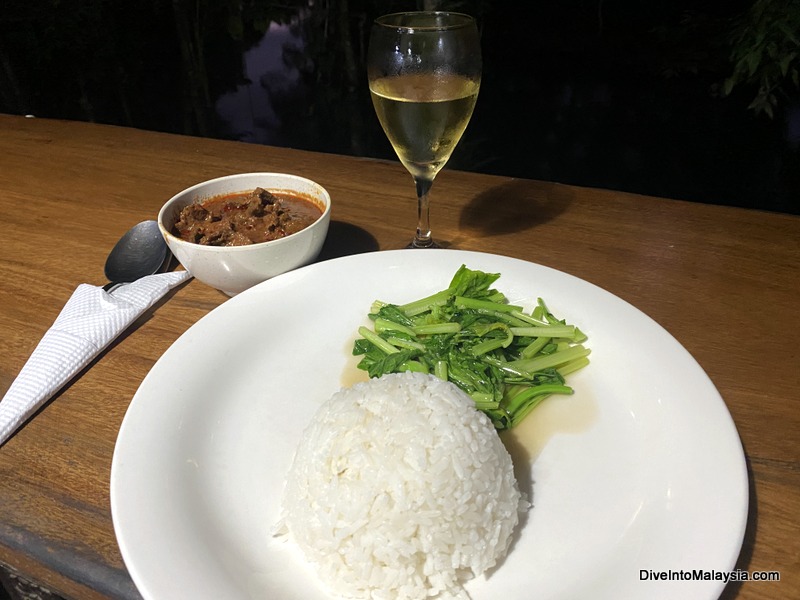
Due to the effort involved in getting food here, they can run out of ingredients at times.
There are other eating options as well. There is a Marriott Cafe at the Marriott Resort and some more local options on the roads around Mulu. You can find options by walking out of the national park and walking along the road. You’ll find everywhere is pricier than what you are used to paying elsewhere in Malaysia thanks to the difficulty in getting items to Mulu.
There are also some small shops where you can buy supplies including at the Mulu gift shop at Park Headquarters.
As for water, fortunately, there are water taps with drinking water at the entrance to both the Park Headquarters and the Cafe. Plus, if you are staying in the National Park, there are signs in the rooms saying the water is safe to drink in here too. It’s a great way to save on plastic waste and to save money too.
Gunung Mulu National Park Tour Packages
The best and easiest way to visit this national park is with a tour package.
Gunung Mulu tour packages usually include your accommodation, breakfast and activities. Generally, you need to buy your flights yourself, but it is also possible to get a Mulu Caves tour from Miri which includes this.
This is by far the best way to go because you will need to book tours anyway to see any of the caves or do the more adventurous hiking.
While it is possible to turn up in Mulu and sort out your accommodation and tours on arrival, there is no guarantee there will be beds or tours for you, particularly if you travel in peak season from June to September.
I recommend at a minimum that you book your flights, accommodation and the main tours you 100% have to do to make the visit worthwhile for you. There is lots of information above so you can work out what tours you want to do.
Local Malaysian travel agencies can book this with you or you can book direct with the park or a hotel.
If you want to book direct with Park Headquarters, you can book their accommodation and/or tours through their website here.
You can also book direct with Marriott Resort here.
Gunung Mulu National Park Map
The Gunung Mulu National Park is located in the north eastern part of the Malaysian state of Sarawak. It is very close to the Brunei border.
The Gunung Mulu National Park location is not on any roads which is part of what makes a visit here great. However, it does mean that, realistically, you are going to fly to get here. The good news is that there is an airport here so you can do that.
How To Get To Gunung Mulu National Park Sarawak Malaysia
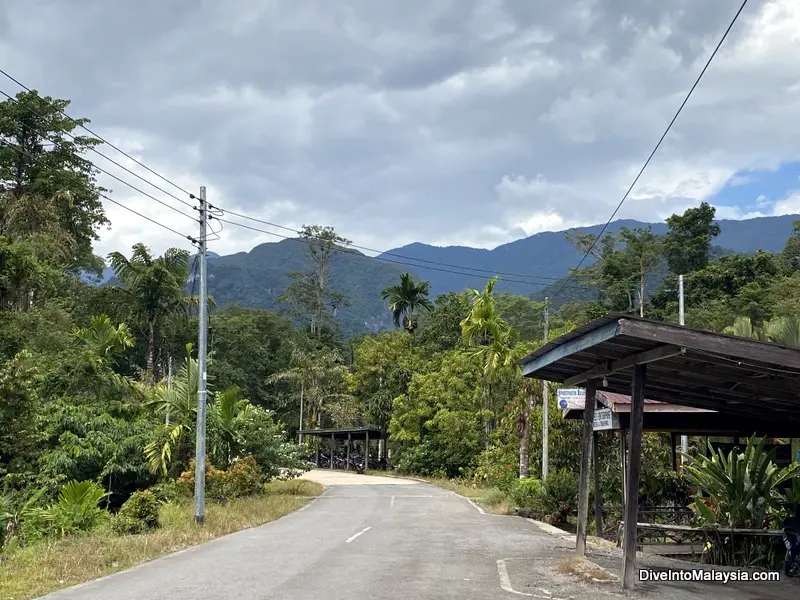
As mentioned above, realistically you need to fly to Mulu Caves. It is possible to hike, take boats and drive part of the way from Limbang on the Headhunters Trail (described above), but this costs more and takes much more time than flying. The vast majority of people fly in and out.
There are flights from Kuching, Kota Kinabalu and Miri on MASWings, the regional carrier for Malaysian Airlines. Most flights leave from Miri.

If you want to know how to go Mulu Caves from Miri, this flight from Miri to Mulu Cave takes just 30 minutes and generally leaves a couple of times a day. Prices start at about RM120.
If you want to fly Kuching to Mulu Caves, there is a daily flight in the morning. It takes about 1 hour and 40 minutes and starts at around RM240.
If you want to fly Kota Kinabalu to Mulu Caves, this takes about 55 minutes and prices start at RM220.

If you want to know how to get to Mulu Caves from Kuala Lumpur, you need to take two flights. You can connect via Miri, Kuching or Kota Kinabalu by flying Malaysian Airlines and then connecting to the MASWings flight. This makes it quite straightforward to go from Kuala Lumpur to Mulu Caves.
If you want to come from anywhere else, you’ll be looking for flights as well.
To see all the latest flights and prices, click here.
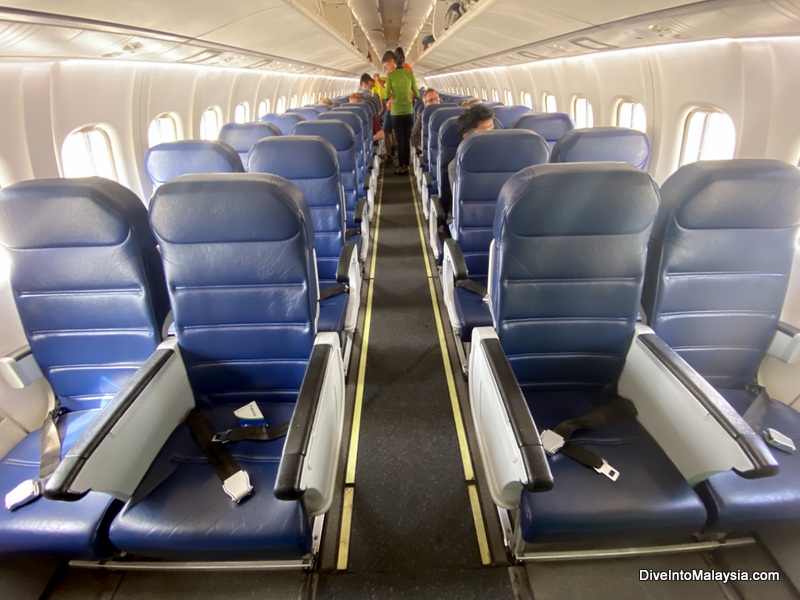
I flew from Kuching to Mulu and then to Miri afterwards. It was all very straightforward.
Gunung Mulu National Park With Kids
While I didn’t travel with my kids this time to Mulu National Park, I would love to come with them next time. I saw many families with kids at this park from 4 weeks old to nearly adults. I think it would be especially great with teenagers, but I had kids that were around 7 years old on my tours.
For kids who love the outdoors, I think this is a great place to take kids. There are lots of outdoor adventures to be had!
While I wouldn’t walk with them to the Gunung Mulu Pinnacles, there is lots they can do, like visit the main Show Caves, watch the Bat Exodus and my kids love a good canopy walk.
I think it’s definitely a place families should consider visiting. I’m sure I’ll bring mine soon.

Best Time to Visit Gunung Mulu National Park
The weather at Mulu does not change that much. All year round, it is hot and humid and you can expect rain. However, the driest months are June to September, although these are also slightly hotter than the rest of the year with average temperatures from 21 – 29 degrees.
This coincides with the peak visitor times which are June to September.
So it can be easier to visit outside this period when it is less busy.

What To Pack
You are entering the rainforest to trek, climb and cave so it’s important to have the right gear. There is a lack of supplies and shops, so have everything you need.
Its humid and clothes can struggle to dry so lightweight, quick drying clothes (and enough of them) are essential. You will no doubt get wet at some point. Pretty much every time I went somewhere, my clothes were covered in sweat and I needed to wash them.
You can get your washing done at Park Headquarters. It’s per item with costs from RM2-4 per item. So more expensive that a laundry elsewhere but cheaper than the vast majority of hotel laundry services. I had some of my clothes washed in less than 24 hours.
Also make sure you pack:
- Suncreen
- Hat
- Rain gear
- Great hiking shoes/boots
- First aid kit and any medications you need
- Torch/flashlight/head lamp
- Water bottle
If you do a more specialised trek or caving experience, make sure you find out any gear you need and bring it too.
Leach socks are generally not needed unless you are taking some of the big hikes. If you are visiting Mulu for the Show Caves and other easy walks, you are on boardwalk most of the time and leaches are not usually a problem. Mosquitoes are also not a problem thanks to all the bats.
Note that there is no ATM in Mulu. Take all the cash you could possibly need for your time in Mulu with you. Some places do take card, but it’s better to be safe than sorry.
Final Words

I hope you enjoyed this full guide to Mulu National Park and have had all your questions answered and are now ready to go!
I very much enjoyed visiting here. It’s amazing. From the show caves to the rainforest itself to the great accommodation that helps you truly enjoy your visit here. I even loved the flight in which was like a special scenic flight!
I really loved how accessible and easy amazing experiences are at this park. It’s very well run, prices are crazy reasonable and really, anyone can have a fantastic visit here. It’s an experience I haven’t had matched anywhere in the world.
I imagine for more adventurous people, it would be even more thrilling with the adventure caves and the Pinnacles walk.
Whatever your thrill level, Gunung Mulu National Park is exceptional and I highly recommend a visit here.
You can find our full guide to Mulu Park accommodation here. This has all options in Mulu. Don’t forget our full guide to the caves in Mulu here. There is much more information here than in this guide.
Visiting Miri on your way to or from Mulu National Park? Check out things to do while in Miri here and our full travel guide to Miri here. If you are heading to Kuching instead, find our guide to Kuching here or read about Kota Kinabalu here.
Planning a trip to Malaysia? Have any questions? Join our Malaysia Travel Planning Facebook group here now! It’s the perfect place to ask any questions and to be inspired!


